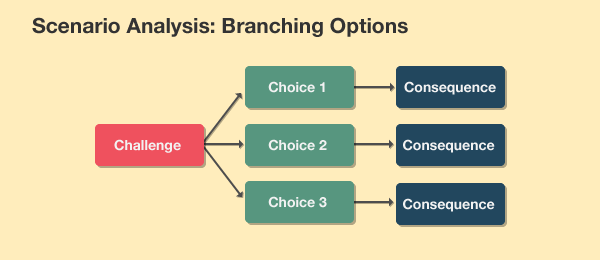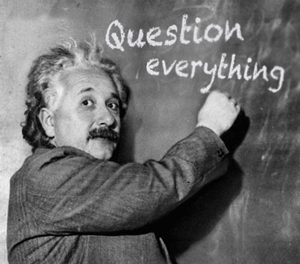“What if” scenarios are tools used in planning and analysis to help organizations anticipate and prepare for possible futures. These scenarios allow us to explore and understand possible combinations of cause and effect, especially in those cases that are highly uncertain but could have a significant impact on a company’s operations or environment.
“What if” scenarios allow us to explore alternative futures, taking into account multiple possible options, not just the most likely or desired one. By seeing how scenarios vary depending on each variable, we can identify critical factors such as events, trends or key aspects that could significantly influence the future of the organization. This insight allows us to develop a coherent narrative for each scenario, a very useful tool in committees, as we can provide details on how that particular future might evolve.
Thus, “What if” scenarios are impact analysis tools where we evaluate how each scenario could affect the organization and what actions should be taken to take advantage of the opportunities or mitigate the associated risks.
Common applications of “What if” scenarios:
- Strategic Planning: They help organizations develop flexible strategies that can adapt to different possible futures.
- Risk Management: They enable organizations to identify potential risks and prepare for them, even if those risks are uncertain or unforeseen.
- Decision Making: They provide a solid basis for making informed decisions, especially in situations of high uncertainty.
- Innovation: They provide a space to think creatively and outside the box, which can lead to the identification of new opportunities or innovative solutions.
We are already seeing that “What if” scenarios are a valuable tool that allows organizations to prepare for the future proactively and strategically, rather than simply reacting to changes as they occur.
But in these scenarios, it is not only necessary to ask “What if?” but also “Why not?”, i.e., to think about what would happen if we were to influence each of the variables in the scenarios proactively.
Asking these types of questions and analyzing their consequences have proven to be powerful tools for anticipating the future and driving change, innovation and, above all, digital transformation.
For example, asking “What if all our employees could work from anywhere in the world?” can lead to the adoption of remote work tools and more flexible policies, making it easier to attract global talent. On the other hand, “Why don’t we implement a new data analytics tool?” could result in a greater understanding of customer needs and the creation of more accurate products.
Two simple questions, “What if…?” and “Why not…?” that can take on unexpected relevance.
But asking these questions is nothing new. Ever since human beings began to observe their environment and question the why of things, innovation has been a driver of progress. Great advances in science, technology and art have emerged from the simple question, “What if?”. This is the innate power of curiosity. Just imagine our ancestors, trying things like eating a strawberry, looking as dangerous as they do.
Organizations have followed a similar pattern. Companies that once asked themselves how to improve their products, processes or services, or that questioned traditional methods, are the ones that made the difference in the marketplace. Although to be fair it must be said that sometimes they got it right and sometimes not. Instead of the strawberry, they ate a poisonous mushroom.

The Power of Challenging the Status Quo
Let’s face it, the status quo is comfortable. However, in an ever-changing world, complacency can be fatal. Organizations that routinely ask these questions are better prepared to meet challenges, anticipate trends and capitalize on opportunities.
When Blockbuster dominated the movie rental market, Netflix asked itself, “What would happen if movies were streamed online?” The answer to that question led not only to the creation of a streaming giant, but also to the obsolescence of an earlier business model.
It is also true that the unknown generates distrust. What if I eat the poisonous mushroom instead of the strawberry? Many organizations fear failure. However, innovation and risk are inseparable. Even here we can anticipate the future. By questioning “What if we fail?”, we not only identify potential obstacles, but also open the door to devising strategies to overcome them. This proactive approach minimizes the risks associated with change and transformation.
Organizations that ask themselves how they can adapt their operations, business models and offerings to the digital world are leading society-wide change.
Banking, for example, has undergone a digital revolution. Institutions that asked, “Why not offer online banking?” or “What if customers could deposit checks using their cell phones?” are at the forefront of customer satisfaction and operational efficiency. Or retail, “Why don’t we remove checkout counters? ” And now we have supermarkets where simply placing a product in the cart adds it to our purchase and when we check out we are charged for it without human intervention.

A Culture of Curiosity
The use of “what if” scenarios and asking questions such as “Why not…?” should not be the exclusive domain of senior management. To truly harness their power, it is critical to instill a culture of curiosity at all levels of the organization. When every employee feels free to question and explore, when employees at all levels ask “Why don’t we do things differently?”, it facilitates more organic and diverse innovation, and then change and innovation becomes an integral part of the company.
We can think of questions like these as having been the cause of actual products and services that changed the status quo in society.
- A question like “What if phones were more than communication devices?” could lead Apple to the creation of the iPhone, a device that transformed not only the cell phone industry, but the way we live and work.
- A question like “Why not allow people to rent their homes to travelers?” among friends revolutionized the lodging industry with the emergence of Airbnb.
It must be remembered that not all answers to these questions will be revolutionary or even viable. But it is the process of questioning and exploring that leads organizations to uncover hidden opportunities and proactively address challenges.
It is clear that the questions “What if…?” and “Why not…?” are more than just questions; they are powerful tools that can determine success or failure in life in general and in the digital age in particular. By considering a variety of possible futures, organizations can be more resilient and adaptive in the face of uncertainty and change.
Throughout history, questioning the status quo, adaptation and evolution have been key to survival. Similarly, for modern organizations, the ability to question, innovate and transform is essential to thrive in the 21st century business landscape.
These questions, in their simplicity, have the power to unlock potential, foster change and ensure that organizations not only stay relevant, but also lead the way into the future. Ultimately, they are a reminder that curiosity and questioning are, and always will be, the fundamental drivers of human progress.